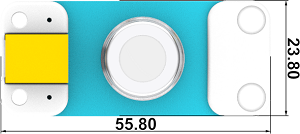CO2 Gas Sensor(EF05030)
Contents
30. CO2 Gas Sensor(EF05030)#
30.1. Introduction#
The higher the CO2 concentration is, the lower the output voltage would be. The CO2 probe is made with industrial grade which is high allergic to CO2 and anti-interference to alcohol and CO.

30.2. Products Link#
30.3. Characteristic#
Designed in RJ11 connections, easy to plug.
30.4. Specification#
| Item | Parameter |
|---|---|
| SKU | EF05030 |
| Connection | RJ11 |
| Type of Connection | Analog output |
| Working Voltage | 3.3V |
30.5. Outlook#

30.6. Quick to Start#
30.6.1. Materials Required and Diagram#
Connect the CO2 sensor to J1 port and the OLED to the IIC port in the Nezha expansion board as the picture shows.

30.7. MakeCode Programming#
30.7.1. Step 1#
Click “Advanced” in the MakeCode drawer to see more choices.

We need to add a package for programming, . Click “Extensions” in the bottom of the drawer and search with “PlanetX” in the dialogue box to download it.

Note: If you met a tip indicating that the codebase will be deleted due to incompatibility, you may continue as the tips say or build a new project in the menu.
30.7.2. Step 2#
30.7.3. Code as below:#

30.7.4. Link#
Link: https://makecode.microbit.org/_2mT2MxX236EM
You may also download it directly below:
30.7.5. Result#
The detected value of the CO2 Gas sensor display on the OLED screen.
30.8. Python Programming#
30.8.1. Step 1#
Download the package and unzip it: PlanetX_MicroPython
Go to Python editor

We need to add enum.py and CO2.py for programming. Click “Load/Save” and then click “Show Files (1)” to see more choices, click “Add file” to add enum.py and CO2.py from the unzipped package of PlanetX_MicroPython.



30.8.2. Step 2#
30.8.3. Reference#
from microbit import *
from enum import *
from co2 import *
co2 = CO2(J1)
while True:
display.scroll(co2.get_co2())
30.8.4. Result#
The detected value of the CO2 Gas sensor display on the micro:bit.
